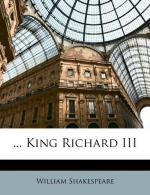|
This section contains 4,071 words (approx. 14 pages at 300 words per page) |

|
SOURCE: “The Wooing of Lady Anne: A Psychological Inquiry,” in Shakespeare Quarterly 29, No. 1, Spring, 1978, pp. 28-36.
In the following essay, Shupe psychoanalyzes the wooing scene between Richard and Anne, concluding that its outcome is realistic because Richard is a highly persuasive Machiavellian type and because Anne is confused and vulnerable.
Early in Richard III, Richard, as part of his plot to win the throne, decides to marry the Lady Anne. He undertakes her wooing at what would appear to be the least propitious moment for such an enterprise, during the funeral procession for her father-in-law, Henry VI, whom Richard has murdered. Richard, already responsible for the death of her husband, could hardly be surprised at the storm of vituperation Anne pours forth when he accosts the procession. Yet, less than 180 lines after Anne's “Avaunt, thou dreadful minister of hell!” (I. ii. 46),1 she takes leave of Richard with the...
|
This section contains 4,071 words (approx. 14 pages at 300 words per page) |

|


